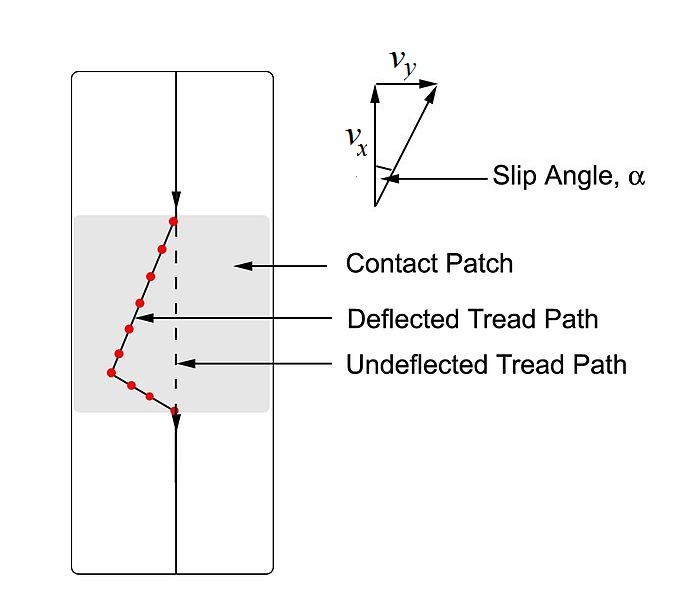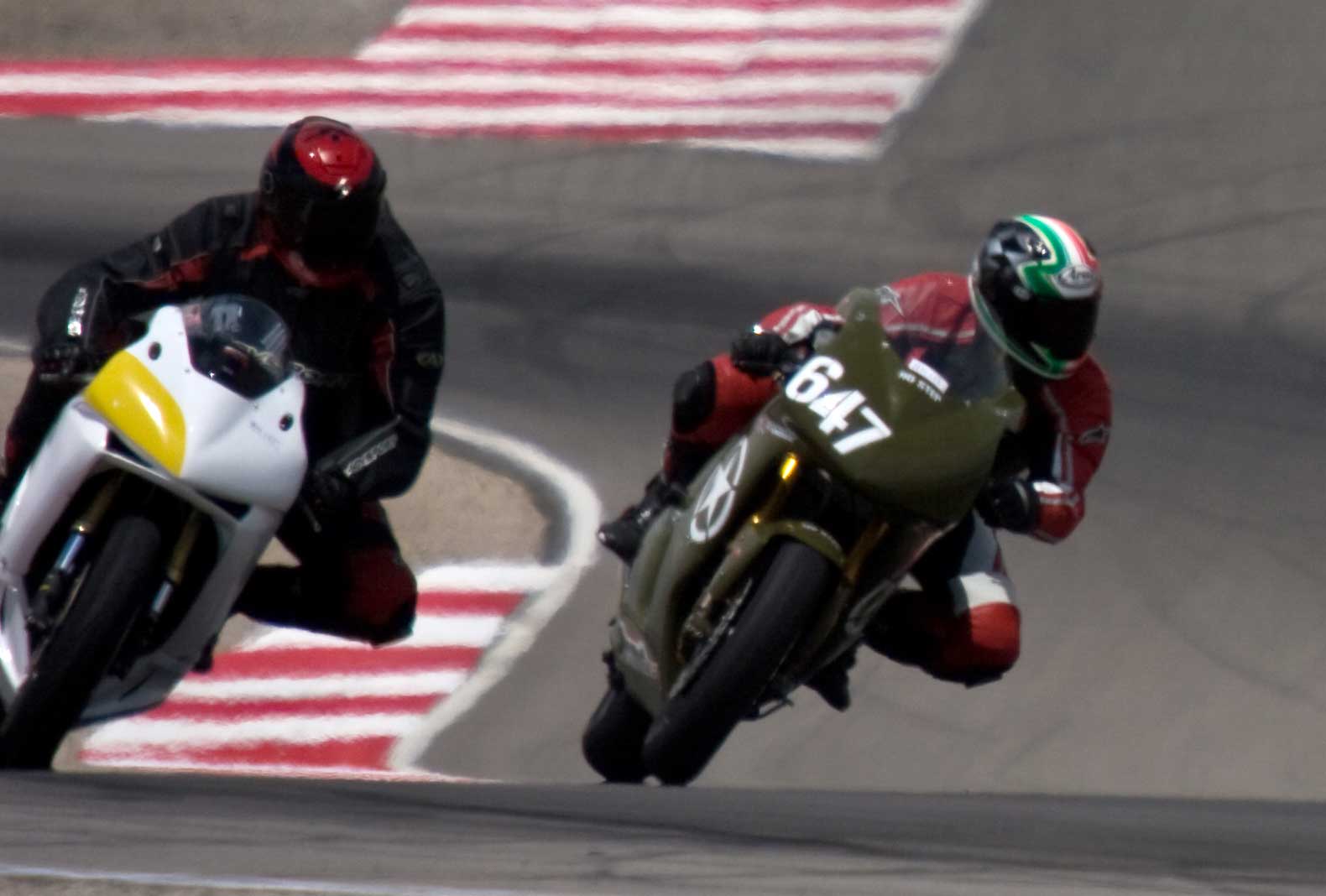|
Slip Angle
In vehicle dynamics, slip angle or sideslip angle is the angle between the direction in which a wheel is pointing and the direction in which it is actually traveling (i.e., the angle between the forward velocity vector v_x and the vector sum of wheel forward velocity v_x and lateral velocity v_y, as defined in the image to the right). This slip angle results in a force, the cornering force, which is in the plane of the contact patch and perpendicular to the intersection of the contact patch and the midplane of the wheel. This cornering force increases approximately linearly for the first few degrees of slip angle, then increases non-linearly to a maximum before beginning to decrease. The slip angle, \alpha is defined as \alpha \triangleq -\arctan\left(\frac\right) Causes A non-zero slip angle arises because of deformation in the tire carcass and tread. As the tire rotates, the friction between the contact patch and the road results in individual tread 'elements' (finite s ... [...More Info...] [...Related Items...] OR: [Wikipedia] [Google] [Baidu] |
Anti-roll Bar
An anti-roll bar (roll bar, anti-sway bar, sway bar, stabilizer bar) is an automobile suspension part that helps reduce the body roll of a vehicle during fast cornering or over road irregularities. It links opposite front or rear wheels to a torsion spring using short lever arms for anchors. This increases the suspension's roll stiffness—its resistance to roll in turns. The first stabilizer bar patent was awarded to Canadian inventor Stephen Coleman of Fredericton, New Brunswick on April 22, 1919. Anti-roll bars were unusual on pre-WW2 cars due to the generally much stiffer suspension and acceptance of body roll. From the 1950s on, however, production cars were more commonly fitted with anti-roll bars, especially those vehicles with softer coil spring suspension. Purpose and operation An anti-sway or anti-roll bar is intended to reduce the lateral tilt (roll) of the vehicle on curves, sharp corners, or large bumps. Although there are many variations in design, the ob ... [...More Info...] [...Related Items...] OR: [Wikipedia] [Google] [Baidu] |
Automotive Safety
Automotive safety is the study and practice of automotive design, construction, equipment and regulation to minimize the occurrence and consequences of traffic collisions involving motor vehicles. Road traffic safety more broadly includes roadway design. One of the first formal academic studies into improving motor vehicle safety was by Cornell Aeronautical Laboratory of Buffalo, New York. The main conclusion of their extensive report is the crucial importance of seat belts and padded dashboards. However, the primary vector of traffic-related deaths and injuries is the disproportionate mass and velocity of an automobile compared to that of the predominant victim, the pedestrian. According to the World Health Organization (WHO), 80% of cars sold in the world are not compliant with main safety standards. Only 40 countries have adopted the full set of the seven most important regulations for car safety. In the United States, a pedestrian is injured by a motor vehicle every 8 mi ... [...More Info...] [...Related Items...] OR: [Wikipedia] [Google] [Baidu] |
Trail Braking
Trail braking is a driving and motorcycle riding technique where the brakes are used beyond the entrance to a turn (turn-in), and then gradually released (trailed off). Depending on a number of factors, the driver fully releases brake pressure at any point between turn-in and the apex of the turn. Motorcycling In applying this technique, motorcycle riders approach turns applying front brakes to reduce speed. As they enter the turn, they slowly ease off the brakes, gradually decreasing or trailing off the brakes as motorcycle lean increases. This is done for several reasons. First, it gives more traction because the downward force on the front tire is increased by load transfer. Second, as the brakes are applied and the weight shifts forward, the forks are compressed. The compression of the forks changes the motorcycle's steering geometry, decreasing stability in a way that makes the motorcycle more apt to lean and more quickly change direction. Third, decreasing speed decre ... [...More Info...] [...Related Items...] OR: [Wikipedia] [Google] [Baidu] |
Traction Circle
Traction may refer to: Engineering *Forces: ** Traction (mechanics), adhesive friction or force ** Traction vector, in mechanics, the force per unit area on a surface, including normal and shear components * Traction motor, an electric motor used for propulsion of a vehicle, for example a car or a locomotive * Railway electric traction, the use of electric motors to propel rail cars * Traction engine, a self-propelled steam engine Other uses * Traction (agency), San Francisco-based interactive advertising agency * Traction (orthopedics), a set of mechanisms for straightening broken bones or relieving pressure on the skeletal system * Traction (organization), a non-profit activism organization in North Carolina * ''Traction'' (album), by New Zealand band Supergroove * Traction TeamPage, a commercial blog/wiki software platform * Traction (The Batman), 2nd episode of ''The Batman'' * Traction (geology), a process which transports bed load through a channel See also *Tracktio ... [...More Info...] [...Related Items...] OR: [Wikipedia] [Google] [Baidu] |
Slip (vehicle Dynamics)
In (automotive) vehicle dynamics, slip describes the relative motion between a tire and the road surface it is moving on. This slip can be generated either by the tire's angular velocity being greater or less than the free-rolling speed (referred to as slip ratio), or by the tire A tire (North American English) or tyre (Commonwealth English) is a ring-shaped component that surrounds a Rim (wheel), wheel's rim to transfer a vehicle's load from the axle through the wheel to the ground and to provide Traction (engineeri ...'s front facing direction being at an angle to its direction of motion (referred to as slip angle). When both of these measurements do not equal zero, the tire enters a state called combined slip. Longitudinal slip ratio The longitudinal slip (commonly referred to as longitudinal slip ratio) is used to describe the rotational state of a tire at any given speed. The most common definition is given as the ratio between the tire's slip velocity and the forwa ... [...More Info...] [...Related Items...] OR: [Wikipedia] [Google] [Baidu] |
Cornering Force
Cornering force or side force is the lateral (i.e., parallel to wheel axis) force produced by a vehicle tire during cornering. Cornering force is generated by tire slip and is proportional to slip angle at low slip angles. The rate at which cornering force builds up is described by relaxation length. Slip angle describes the deformation of the tire contact patch, and this deflection of the contact patch deforms the tire in a fashion akin to a spring. As with deformation of a spring, deformation of the tire contact patch generates a reaction force in the tire; the cornering force. Integrating the force generated by every tread element along the contact patch length gives the total cornering force. Although the term, "tread element" is used, the compliance in the tire that leads to this effect is actually a combination of sidewall deflection and deflection of the rubber within the contact patch. The exact ratio of sidewall compliance to tread compliance is a factor in ... [...More Info...] [...Related Items...] OR: [Wikipedia] [Google] [Baidu] |
Camber Thrust
Camber thrust and camber force are terms used to describe the force generated perpendicular to the direction of travel of a rolling tire due to its camber angle and finite contact patch. Camber thrust is generated when a point on the outer surface of a leaned and rotating tire, that would normally follow a path that is elliptical when projected onto the ground, is forced to follow a straight path while coming in contact with the ground, due to friction. This deviation towards the direction of the lean causes a deformation in the tire tread and carcass that is transmitted to the vehicle as a force in the direction of the lean. Camber thrust is approximately linearly proportional to camber angle for small angles, reaches its steady-state value nearly instantaneously after a change in camber angle, and so does not have an associated relaxation length. Bias-ply tires have been found to generate more camber thrust than radial tires. Camber stiffness is a parameter used to describe the ... [...More Info...] [...Related Items...] OR: [Wikipedia] [Google] [Baidu] |
University Of Padua
The University of Padua (, UNIPD) is an Italian public research university in Padua, Italy. It was founded in 1222 by a group of students and teachers from the University of Bologna, who previously settled in Vicenza; thus, it is the second-oldest university in Italy, as well as the world's fifth-oldest surviving university. The University of Padua was one of the most prominent universities in early modern Europe, known particularly for the rigor of its Aristotelian logic and science. Together with the University of Bologna, Padua had a central role in the Italian Renaissance, housing and educating a number of Italian Renaissance mathematicians, amongst them Nicolaus Copernicus. , it is made up of 32 departments and eight schools. Padua is part a network of historical research universities known as the Coimbra Group. In 2021, the university had approximately 72,000 students including undergraduates, postgraduates, and doctoral students. History The university is conventionally s ... [...More Info...] [...Related Items...] OR: [Wikipedia] [Google] [Baidu] |
Motorcycle Tire
A motorcycle tyre (spelt tire in American English) is the outer part of motorcycle wheel, attached to the rim, providing traction, resisting wear, absorbing surface irregularities, and allowing the motorcycle to turn via countersteering. The two tyres' contact patches are the motorcycle's connection to the ground, and so are fundamental to the motorcycle's suspension behaviour, and critically affect safety, braking, fuel economy, noise, and rider comfort. History The history of motorcycle tyres is a clear progression of steady improvement in grip, allowing better acceleration, braking, and turning, along with improved comfort, safety, durability, and reliability. This progression has generally meant a steady increase in tyre width, so much so that Kevin Cameron noted the assumption among riders that "bigger must be better in every way", leading to, "the temptation to overwhelm motorcycles with the biggest tyres the owner can find." While many advances in tyre materials and c ... [...More Info...] [...Related Items...] OR: [Wikipedia] [Google] [Baidu] |






